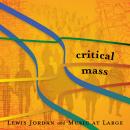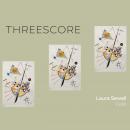Voyage Apollonian
Voyage Apollonian
Rio de Janeiro, Brazil
| Voyage ApollonianiTunes Artist's PageiTunes Album Page | |||
|---|---|---|---|
| Song Title | Time | Price | |
| 1. | Voyage Apollonian | 05:53 | $0.99 |
| 2. | JanMaricana (For Subharmonics) | 04:47 | $0.99 |
| 3. | Frevo (Arr. M. Kimura) | 05:24 | $0.99 |
| 4. | Eigenspace | 07:03 | $0.99 |
| 5. | Canon élastique | 03:22 | $0.99 |
| 6. | Coisa Feita (Arr. M. Kimura) | 03:17 | $0.99 |
| 7. | Breuer vivant | 07:11 | $0.99 |
| 8. | Bebê (Arr. M. Kimura) | 04:43 | $0.99 |
| 9. | Kaze (The Wind) | 07:15 | $0.99 |
One of an instrument’s most obvious limits is its highest and lowest notes. Usually. But for generations, musicians have found ways of pushing past even those most obvious physical limits. Pushing past them is, in fact, not necessarily a great feat in and of itself. But when a musician like Mari Kimura (composer, violinist, and Juilliard prof) can take the violin below its lowest notes so evocatively and dynamically with her remarkable subharmonic bowing technique, the effect is striking.
Voyage Apollonian showcases that technique on “JanMaricana for Subharmonics,” where Kimura explores undertones beyond the more typical octave, including a fifth below the fundamental tone -- a technique that eluded her for years until a breakthrough that allowed her to harness it reliably. The piece evokes the Bohemian flavors of Smetana and Dvořák, honoring the home country of Jan and Marica Vilcek to whom JanMaricana is dedicated.
All other pieces by Kimura along with the title track employ a WIFI motion sensor designed to extract musical expressions based on the motion of the bow. Through this technology, Kimura can create second voices in canon or manipulate the playback through analyzing the quality of the bowing motions. It is like a band in a box, only without the box – all generated in real time.
If all this makes the process sound almost technical, the results are the direct opposite, as illustrated by the inclusion of three dazzling Brazilian jazz transcriptions. Throughout, the performances are organic and warm, with every advanced technique or technological interaction disappearing into the fabric of the music itself. The subharmonics and computer accompaniment are not the view itself, they are the finger pointing at the moon, lenses that focus understanding. As Jim O’Rourke writes in the liner notes, “French electroacoustic composer Bernard Parmegiani once created a fine work called ‘L’œil Écoute’ (The Eye Hears) and I would propose a subtitle for this collection, ‘The Ear Sees.’”
"The album’s main business, though, is Kimura’s own music. Kimura is an eloquent violinist whose tonal palette ranges from the traditional warm, lush hues that would serve her well if she played the standard repertory more to the edgier sounds of extended techniques, at least one of which — the use of subharmonics --- extends the instrument’s range downward, below its natural range. One work here, the unaccompanied Jan Marciana, uses a subharmonic fifth, which she tells us in her program note is new to her arsenal.
The most evocative of her offerings are those for violin and interactive computer, which she uses here as an orchestra so flexible that it seems unbound by the laws of physics and the timbral limitations of conventional instruments. In the title piece, an electronic string orchestra shimmers, slides in unison into a reverb-heavy distance, and morphs into tactile percussion. Here, and in Eigenspace, a sometimes introspective, sometimes angry meditation on the Fukushima nuclear disaster, old world tonal elegance is combined with modern textural sensibilities, techniques, and effects.
Kimura’s talent for looking to both the past and the future is best represented by Canon Élastique, which uses the Baroque technique in an unusual way. Composed at IRCAM, the piece was created with a ring recorder, a device that records a performance, but allows Kimura to alter and manipulate it with the violin line she plays as the earlier performance is played back. Breuer Vivant also glances backward, embracing an antique form — the passacaglia — as well as the sultry, winding lines of Romanticism, and the rich double-stopping that Fritz Kreisler used so plentifully. Yet the piece also uses electronics to recast these receding styles in thoroughly current terms.” [FULL ARTICLE] - Allan Kozinn
TERAPIJA:
"Her skills in accordance with computer technology spread to WIFI manipulate the movement of other sounds which in real time converts to the canons or play through the analysis of quality, something very much like a onewoman band....This is most obviously shows in the title theme " Voyage apollonian " with which opens the album and giving the impression that with fuzzy gentle violin disonante with her for at least a whole string quartet thanks not only to the computer technology, but also the skill of playing the low octaves typical for cello, and knows how to produce violins and high like a viola. The song has a nice complex arrangement in which manages to enter and staccato, and tremolo. One of the strongest themes is still " JanMaricana (for Subharmonics) " where Kimura explores more than a fifth of fundamental low tone that she escaped from his years, and evokes the Czech school Smetana and Dvořák, in honor of his homeland Jan and Marica Vilcek. " Frevo " the only topic in which the present piano leisurely wander jazzy ambience, while " Eigenspace " and " Canon elastique " psychedelic songs that sound in space ether. A good portion of the program, and entertainment for softer note is linked to the Brazilian jazz transcriptions " Coisa Feita ", " Breuer Vivant " and " Bebe " in which, accompanied by acoustic guitar or piano in melodic improvisation put them 'poppy on a thread' that not only strict and demanding an innovator but also a kind of entertainer."
"Julliard professor Mari Kimura plays her violin with an interactive computer to include sounds that explore the undertones and subtones of her instrument. She creates the appearance of a second string, without the concept coming across as a gimmick, as she creates pizzicato dialogues on “Frevo” or the Sibelius themed “Breuer Vivant.” Modern classical rhapsodies are felt on “Canon Elastique,” while with electronics, she creates sepia moods on “Kaze (The Wind” or visceral melancholia on “Voyage Apollonian” while fascinating textures abound with strings sighing on “Jan Maricana.” Lots to pay attention to here." [FULL ARTICLE] - George Harris
“‘Voyage Apollonian’ covers a great deal of territory; from Brazilian sambas and jazz to unaccompanied violin with subharmonics to new musical interfaces with interactive computer technology. Despite the use of cutting edge technology and new innovative acoustic techniques the music on this disc does not sound very “technical”. The use of technology is at the service of the performer and has been carefully designed to be flexible and expressive. In Kimura’s hands the results are a highly expressive music that is warm and organic, rich in color and nuance. Highly recommended.” [FULL ARTICLE] - Chris DeChiara
“Really interesting this CD of composer and violinist Mari Kimura...whose rhythmic vitality and melodic freshness receives new life from an imaginative arrangement but always true to the spirit of these three great composers.” [FULL ARTICLE] - Filippo Focosi
"Work typically contemporary, with moments of great suggestion and made even more varied by the three delicious tributes to Brazil" [FULL ARTICLE] - Neri Pollastri



